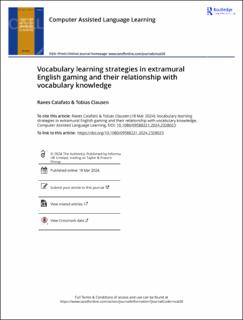| dc.contributor.author | Calafato, Raees | |
| dc.contributor.author | Clausen, Tobias | |
| dc.date.accessioned | 2024-03-20T13:10:05Z | |
| dc.date.available | 2024-03-20T13:10:05Z | |
| dc.date.created | 2024-03-19T10:40:34Z | |
| dc.date.issued | 2024 | |
| dc.identifier.citation | Calafato, R., & Clausen, T. Vocabulary learning strategies in extramural English gaming and their relationship with vocabulary knowledge. Computer Assisted Language Learning, 1-19. | en_US |
| dc.identifier.issn | 0958-8221 | |
| dc.identifier.uri | https://hdl.handle.net/11250/3123417 | |
| dc.description.abstract | Research has shown that students learning English as a foreign language can enhance their vocabulary knowledge through exposure to the target language outside of school. However, little is known about whether certain extramural activities have stronger links with vocabulary acquisition than others, and more crucially, the extent to which the vocabulary learning strategies that learners employ during extramural English encounters affect vocabulary learning outcomes. The study reported in this article investigated the relationship between the vocabulary learning strategies employed by 116 students in a Norwegian secondary school when gaming extramurally in English, their gaming frequency, engagement in other EE activities besides gaming, and their receptive and productive English vocabulary knowledge. The findings revealed that inferencing, using language references, and notetaking when gaming statistically significantly correlated with participants’ productive vocabulary knowledge, whereas only inferencing predicted their receptive vocabulary knowledge. Moreover, a negative link was discovered between playing driving games and receptive vocabulary knowledge. | en_US |
| dc.language.iso | eng | en_US |
| dc.rights | Navngivelse 4.0 Internasjonal | * |
| dc.rights.uri | http://creativecommons.org/licenses/by/4.0/deed.no | * |
| dc.title | Vocabulary learning strategies in extramural English gaming and their relationship with vocabulary knowledge | en_US |
| dc.type | Peer reviewed | en_US |
| dc.type | Journal article | en_US |
| dc.description.version | publishedVersion | en_US |
| dc.rights.holder | © 2024 The Author(s). | en_US |
| dc.source.pagenumber | 19 | en_US |
| dc.source.journal | Computer Assisted Language Learning | en_US |
| dc.identifier.doi | https://doi.org/10.1080/09588221.2024.2328023 | |
| dc.identifier.cristin | 2255665 | |
| cristin.ispublished | true | |
| cristin.fulltext | original | |
| cristin.qualitycode | 1 | |

